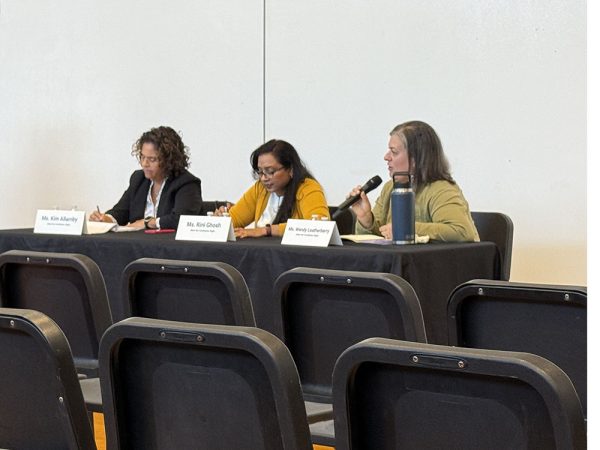School Districts Await Lower Court Action on Dispute Over Chagrin Highlands Tax Revenue

Beachcomber Archives / Grant Gravagna
Eaton Corporation relocated from downtown Cleveland to Chagrin Highlands in 2013.
The Ohio Supreme Court ruled on Sept. 6 to recognize the validity of the disputed agreement to share Chagrin Highlands tax revenue between the Beachwood City School District and Warrensville Heights City Schools.
Since the court ruling, there has been no further action on the issue.
“There have been no negotiations towards the settlement,” said Hardis. “We are waiting to hear when our court date [and who] our judge will be.”
Warrensville had argued that the agreement was not valid because the Ohio Board of Education had not approved it, which is required in school district territory transfers, according to Ohio Revised Code 3311.06.
Beachwood argued that the agreement involved a transfer of tax revenue, not of territory, and so R.C. 3311.06 is irrelevant. The Ohio Supreme Court sided with Beachwood on this issue.
Warrensville also argued that the 1997 agreement was invalid according to Ohio Revised Code R.C. 5705.41 and R.C. 5705.412 because it did not have a fiscal certificate attached.
Beachwood argued that a fiscal certificate was not required because the agreement involved collection rather than the expenditure of money. The Court sided with Beachwood on this issue as well.
Ten days after the court’s ruling, Warrensville filed for the court to reconsider. The motion was declined.
“From our understanding the way our attorneys explained, it’s rare that anyone would ask the court to reconsider, because they made a ruling,” Beachwood Treasurer Michelle Mills said. “But I suppose because it was so close…it was a 4-3 ruling.”
With their ruling, the Ohio Supreme Court remanded the case back to the Cuyahoga County Common Pleas Court. As of now, there has not been a determined trial date or judge.
Since the Supreme Court ruling, there have also been no further negotiations between Warrensville and Beachwood.
According to the Cleveland Jewish News, Beachwood is hoping that the courts recognize the original 1997 agreement that should have gone into effect in 2012 where Beachwood would receive 30% of the tax dollars from the area while Warrensville would receive 70%. If this were to occur, potentially $5,571,421.99 million would be returned to Beachwood representing 30% of tax revenue since 2012.
Mills and Superintendent Dr. Bob Hardis say the money is essential to building up Beachwood’s fund balance.
“This money is used to fund the operations of the schools, and it’s really important for us to always have a balance so that we don’t have to go back to the voters and ask for [their] money,” Hardis said. “It would allow us to use it over a long period of time.”
Superintendent Donald Jolly, Jr. and Warrensville Heights Mayor Brad Sellers could not be reached for comment.
Warrensville City Schools’ Treasurer Michael Rock also declined.
“I won’t be able to directly respond to your questions at this time,” he wrote in an email. “Our work to vigorously protect the interests of our students, our school district and the WHHS community continues.”
Although the median household income of Warrensville Heights residents is less than half of Beachwood residents ($41,712 per year compared to $94,274 for Beachwood) Mills says the school district is quite wealthy in terms of both their fund balance and spending.
“Their cash balance went from $23.6 million to $39.2 million [and] their forecast says they’re going to have over $57 million at the end of the school year,” she said.
Mills says this is good because Warrensville is investing in their schools. However, given that these numbers still exceed their budget, Mills believes that if they were to repay about a million and a half every year, they would still be collecting far more than they are spending.
According to Mills, Beachwood’s fund balance rounded to $24.7 million last year, and she predicts it might fall to $24.3 million this year.
“Their [fund balance] is more than double ours and has grown significantly,” she added. “We’re always trying to manage our per-people expenditures…ours has been relatively flat [while] theirs went up.”
According to the FY 22 state report card, both districts’ per pupil spending increased last year. Last year, Beachwood spent $18,078 per student while Warrensville spent $15,762.
For more background on this issue, see our coverage from last January.

Shreya Chellu (she/her) started writing for the Beachcomber in 2021. She is interested in covering political and social news in Beachwood and enjoys participating...






![“My parents have always said that education is important. My parents are Chinese immigrants, I'm Chinese American, [and that's a] value that has always been ingrained in our community,” said Senior Lyndia Zheng, pictured with Tony Zheng](https://bcomber.org/wp-content/uploads/2025/10/DSC_4244-600x400.jpg)


